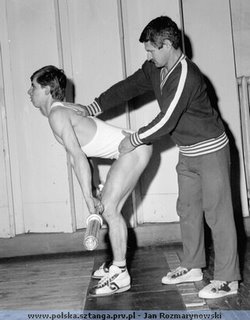 This comment was left on Vern Gambetta’s blog late this week:
This comment was left on Vern Gambetta’s blog late this week: ----------------------------
Vern & Tracy,
great info on the squat...you two are really making me rethink many of the common methods that are taught. i have a question i was hoping you may have time to address: The athlete in Tracy's squat Mediabook appears to have great form, and doesn’t have the common "tuck" in his low back like many athletes do (as thy drop close to parallel, their lumbar spine flexes and leaves the neutral position.) I have read that lack of hamstring flexibility is the culprit, do you agree? do you have any recommendations for correcting besides just improving hamstring flexibility or squatting to work through it?
respectfully,
bryan
-------------------------------
Well Bryan, the short answer is yes, I think it is hamstrings. Might be pure flexibility; it might be some flexibility with some control issues. Correcting it may be challenging, but it is worth the effort in my mind. Initially you have to assess a variety of squats, see how the body (torso, spine, hips, ankles) responds and then go from there.
My new client, TJ, is a 6’1” 150 lb. male volleyball player. He has a long torso, no real history of structured lifting and mildly tight hamstrings as tested with the 90/90 test in supine. He has trouble doing the Waiter’s Bow (ground based hammy stretch)—a staple in my bag of tricks from Wash U PT & Shirley Sahrmann. I teach everyone this hamstring “position” rather than ANY supine work. You work hamstring mobility and learn the hip/spine relationship, in a weight-bearing posture.
TJ cannot do a full back squat without the “dippity-do” at the bottom; this is also true for his bodyweight squats. BUT, he can do a PERFECT rock bottom FRONT SQUAT; I’m talking pure neutral spine all the way. Because his torso is forced to stay more vertical, the hamstring limitation does not rear its ugly head. And, if we have him hold a 10 kg plate behind his head and do a squat, he can keep his neutral lumbar spine almost every rep. BUT, I have to cue him to THINK about what he’s doing (“be controlled all the way down”) and continually ask him how the front squat/plate squat feels compared to the others.
So, right now, I will use front squats for “work” and we’ll use all of these other squat movements in warm up, constantly working to build functional mobility in the hammies for back squats and bodyweight squats. We do several sets of 5 plates squats, 5 bodyweight squats, 5 front squats, 5 back squats—all are light--and I’m constantly making him give me verbal feedback on his proprioceptive awareness of his pelvis/spine position.
I’m certain some of this is torso strength/control too. In my experience, every person is a bit different and responds to different manual and verbal cues. Regardless of the approach, I do feel it is absolutely necessary to put your hands on the pelvis to help the athlete understand what it is like to lengthen the hammies with anterior rotation of the pelvis in the Waiter’s Bow and squat position. Maybe it is the PT in me, but I put my hands on people’s hips all the time—male and female. I’m not sure male coaches or ATCs or PTs feel as comfortable doing this, especially in the litigious school environment. And for coaches, I’m sure there is a “guy thing” there. But it really helps to have that manual cue and crank on the pelvis. Then the light bulb goes off.
To summarize, Bryan, we squat with it—not just through it. I don't load a compromised spine. We work to develop functional, ground-based hamstring mobility with a variety of techniques. I insist on feedback from the athlete during and after sets to make sure s /he is attending to the task as well; and I hammer home the importance of this position for powerful, efficient force transmission from the ground to the upper body, as well as for protection of the lumbar spine.


Comments